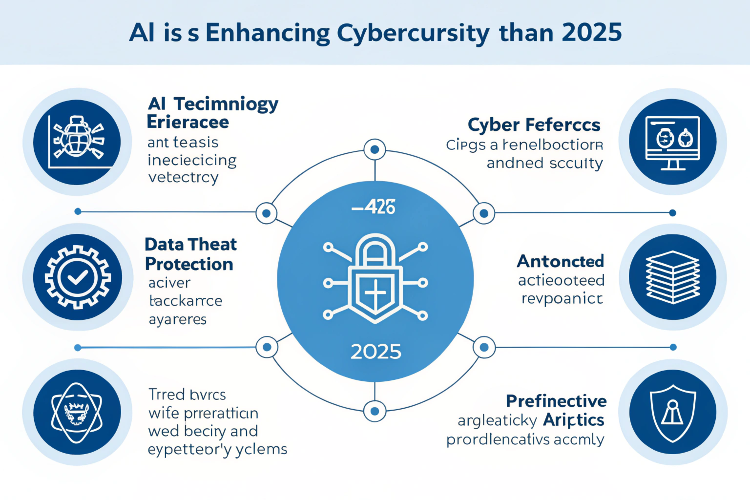Blog
How AI is Enhancing Cybersecurity in 2025
Artificial Intelligence & Automation ▪ 2025-03-07

As we enter 2025, cybersecurity threats are becoming more sophisticated, targeting individuals, businesses, and governments worldwide. With cyberattacks growing in complexity, artificial intelligence (AI) has emerged as a crucial tool in the fight against cybercrime. AI-powered cybersecurity solutions are revolutionizing how we detect, prevent, and respond to cyber threats, offering enhanced protection against hackers, malware, and data breaches.
This blog explores how AI is transforming cybersecurity in 2025, its benefits, challenges, and future trends in safeguarding digital assets.
The Role of AI in Modern Cybersecurity
1. Real-Time Threat Detection and Response
Traditional cybersecurity measures often rely on predefined rules and signatures to identify threats. However, AI-driven security systems use machine learning to analyze network behavior in real-time, detecting anomalies and potential threats instantly. This proactive approach minimizes response time and prevents data breaches before they occur.
2. Predictive Analytics for Cyber Threat Intelligence
AI-powered cybersecurity solutions utilize predictive analytics to anticipate cyber threats based on historical data. By analyzing past attack patterns, AI can predict future vulnerabilities, allowing organizations to strengthen their defenses before an attack takes place.
3. Automated Incident Response and Mitigation
AI-driven security automation enables faster and more efficient responses to cyber threats. When a security breach is detected, AI can automatically initiate countermeasures such as isolating affected systems, blocking malicious IPs, and notifying security teams, reducing human intervention and response time.
4. AI in Fraud Detection and Prevention
Financial institutions and e-commerce platforms leverage AI to detect fraudulent transactions. AI algorithms analyze transaction data in real-time, flagging suspicious activities and preventing financial fraud. This helps reduce chargebacks, identity theft, and unauthorized transactions.
5. AI-Enhanced Endpoint Security
With remote work becoming the norm, endpoint security is more critical than ever. AI-driven security software continuously monitors devices such as laptops, smartphones, and IoT devices, identifying potential security breaches and preventing malware infections.
Key AI Technologies Used in Cybersecurity
1. Machine Learning (ML)
Machine learning algorithms enhance cybersecurity by identifying patterns in vast datasets. ML models are trained to recognize malicious behaviors and adapt to new threats, improving overall threat detection and response.
2. Natural Language Processing (NLP)
NLP enables AI systems to analyze text-based threats, such as phishing emails, social engineering attacks, and malicious code. AI can detect fake emails and warn users before they fall victim to cyber scams.
3. Deep Learning
Deep learning models, inspired by the human brain, enhance AI’s ability to detect sophisticated cyber threats. These models can identify complex attack patterns that traditional security tools might miss.
4. Behavioral Analysis
AI uses behavioral analysis to monitor user activity and detect anomalies. If an employee suddenly accesses sensitive data outside of their usual behavior, AI can flag this activity and trigger security alerts.
Benefits of AI in Cybersecurity
1. Enhanced Threat Detection
AI-powered cybersecurity solutions detect threats with higher accuracy and speed compared to traditional methods, reducing the chances of security breaches.
2. Reduced Human Error
Many cybersecurity breaches result from human error, such as clicking on phishing links. AI minimizes human involvement in security processes, reducing risks associated with manual mistakes.
3. Scalability and Adaptability
AI can handle vast amounts of data and adapt to emerging cyber threats, making it an ideal solution for large organizations and government agencies.
4. Cost Efficiency
Implementing AI-driven security solutions reduces the need for extensive human cybersecurity teams, lowering operational costs while maintaining high levels of protection.
5. Improved Data Privacy Compliance
AI helps businesses comply with data protection regulations by monitoring compliance violations and preventing unauthorized data access.
Challenges and Limitations of AI in Cybersecurity
1. AI-Powered Cyber Attacks
While AI enhances security, hackers are also using AI to develop more sophisticated attacks. AI-driven cyber threats require equally advanced defense mechanisms to counteract them.
2. False Positives and False Negatives
AI cybersecurity systems must balance accuracy to avoid false positives (flagging legitimate actions as threats) and false negatives (failing to detect real threats).
3. Data Privacy Concerns
AI systems require vast amounts of data for training, raising concerns about data privacy and ethical use of user information.
4. High Implementation Costs
Deploying AI-driven cybersecurity solutions can be expensive, making it a challenge for small businesses with limited budgets.
5. Continuous Monitoring and Updating
AI models require ongoing updates and training to stay effective against evolving cyber threats, requiring dedicated resources for maintenance.
Future Trends in AI-Powered Cybersecurity
1. AI-Driven Zero Trust Security Models
The Zero Trust model assumes that no one, whether inside or outside an organization, should be trusted by default. AI enhances Zero Trust security by continuously verifying user identities and monitoring network activities.
2. AI-Powered Threat Hunting
Security teams use AI-driven threat hunting tools to proactively search for vulnerabilities and potential breaches before they occur, reducing the risk of cyberattacks.
3. AI and Blockchain Integration
Combining AI with blockchain technology enhances cybersecurity by creating secure, tamper-proof digital records, improving data integrity and reducing fraud risks.
4. AI in Cloud Security
As businesses migrate to the cloud, AI-driven cloud security solutions will play a vital role in protecting data stored in cloud environments.
5. AI-Based Cybersecurity Regulations and Compliance Automation
Governments and organizations will use AI to automate compliance processes, ensuring adherence to cybersecurity regulations and industry standards.

